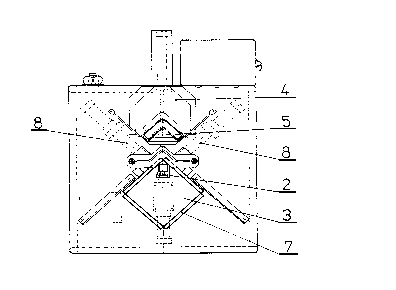Some of the information on this Web page has been provided by external sources. The Government of Canada is not responsible for the accuracy, reliability or currency of the information supplied by external sources. Users wishing to rely upon this information should consult directly with the source of the information. Content provided by external sources is not subject to official languages, privacy and accessibility requirements.
Any discrepancies in the text and image of the Claims and Abstract are due to differing posting times. Text of the Claims and Abstract are posted:
| (12) Patent Application: | (11) CA 2239312 |
|---|---|
| (54) English Title: | APPARATUS FOR ASSEMBLING OF ANGLE PLATES ON THE FLANGES OF VENTILATION DUCTS |
| (54) French Title: | APPAREIL D'ASSEMBLAGE DE PLAQUES D'ANGLE SUR LES BRIDES DE CONDUITS DE VENTILATION |
| Status: | Deemed Abandoned and Beyond the Period of Reinstatement - Pending Response to Notice of Disregarded Communication |
| (51) International Patent Classification (IPC): |
|
|---|---|
| (72) Inventors : |
|
| (73) Owners : |
|
| (71) Applicants : |
|
| (74) Agent: | BORDEN LADNER GERVAIS LLP |
| (74) Associate agent: | |
| (45) Issued: | |
| (86) PCT Filing Date: | 1996-03-29 |
| (87) Open to Public Inspection: | 1997-07-17 |
| Examination requested: | 1998-09-02 |
| Availability of licence: | N/A |
| Dedicated to the Public: | N/A |
| (25) Language of filing: | English |
| Patent Cooperation Treaty (PCT): | Yes |
|---|---|
| (86) PCT Filing Number: | PCT/PL1996/000006 |
| (87) International Publication Number: | WO 1997025179 |
| (85) National Entry: | 1998-06-02 |
| (30) Application Priority Data: | ||||||
|---|---|---|---|---|---|---|
|
The subject of this invention is an apparatus for assembling of angle plates
on the flanges of ventilation ducts. The apparatus comprises an angle plate
(5) advancing device (4) with the two arms carrier (9) and an angle plate (5)
supply hopper (11) over it. The carrier (9) is located on a base plate (19)
with the angle plate (5) shape port (23). A slider (10) has an oblong slot
(12) and a socket (13) and is moving in a guide (25) located in the lower part
of the base plate (19) and a slider (10) working plane (14) with a furrow (26)
performing to-and-fro movement forced by a fluid motor (16) piston rod (15)
joined stably with the slider (10).
L'invention porte sur un appareil comportant un dispositif avançant une plaque angulaire (5) comportant deux bras porteurs (9) et un magasin (11) distributeur de plaques placé au dessus de lui. Les bras porteurs (9) sont montés sur une embase (19) ainsi que l'orifice de formage (23) des plaques d'angle (5). Un élément coulissant (10) comportant une fente oblongue (12) et une douille (13) se déplace le long d'un guide (25) placé à la partie inférieure de l'embase (19), tandis que le plan d'évolution (14) de l'élément coulissant (10) présentant une rainure (26) exécute des mouvements alternatifs, entraîné par la bielle (15) du piston d'un moteur hydraulique (16) relié de manière stable à l'élément coulissant (10).
Note: Claims are shown in the official language in which they were submitted.
Note: Descriptions are shown in the official language in which they were submitted.

2024-08-01:As part of the Next Generation Patents (NGP) transition, the Canadian Patents Database (CPD) now contains a more detailed Event History, which replicates the Event Log of our new back-office solution.
Please note that "Inactive:" events refers to events no longer in use in our new back-office solution.
For a clearer understanding of the status of the application/patent presented on this page, the site Disclaimer , as well as the definitions for Patent , Event History , Maintenance Fee and Payment History should be consulted.
| Description | Date |
|---|---|
| Application Not Reinstated by Deadline | 2001-03-29 |
| Time Limit for Reversal Expired | 2001-03-29 |
| Deemed Abandoned - Failure to Respond to Maintenance Fee Notice | 2000-03-29 |
| Inactive: RFE acknowledged - Prior art enquiry | 1998-12-07 |
| Inactive: IPC assigned | 1998-09-28 |
| Inactive: IPC assigned | 1998-09-28 |
| Inactive: IPC assigned | 1998-09-28 |
| Classification Modified | 1998-09-28 |
| Inactive: First IPC assigned | 1998-09-28 |
| Request for Examination Requirements Determined Compliant | 1998-09-02 |
| All Requirements for Examination Determined Compliant | 1998-09-02 |
| Request for Examination Received | 1998-09-02 |
| Inactive: Notice - National entry - No RFE | 1998-08-26 |
| Application Received - PCT | 1998-08-11 |
| Application Published (Open to Public Inspection) | 1997-07-17 |
| Abandonment Date | Reason | Reinstatement Date |
|---|---|---|
| 2000-03-29 |
The last payment was received on 1999-03-29
Note : If the full payment has not been received on or before the date indicated, a further fee may be required which may be one of the following
Please refer to the CIPO Patent Fees web page to see all current fee amounts.
| Fee Type | Anniversary Year | Due Date | Paid Date |
|---|---|---|---|
| MF (application, 2nd anniv.) - small | 02 | 1998-03-30 | 1998-06-12 |
| Basic national fee - small | 1998-06-12 | ||
| Request for examination - small | 1998-09-02 | ||
| MF (application, 3rd anniv.) - small | 03 | 1999-03-29 | 1999-03-29 |
Note: Records showing the ownership history in alphabetical order.
| Current Owners on Record |
|---|
| WALTER KACZOROWSKI |
| Past Owners on Record |
|---|
| None |